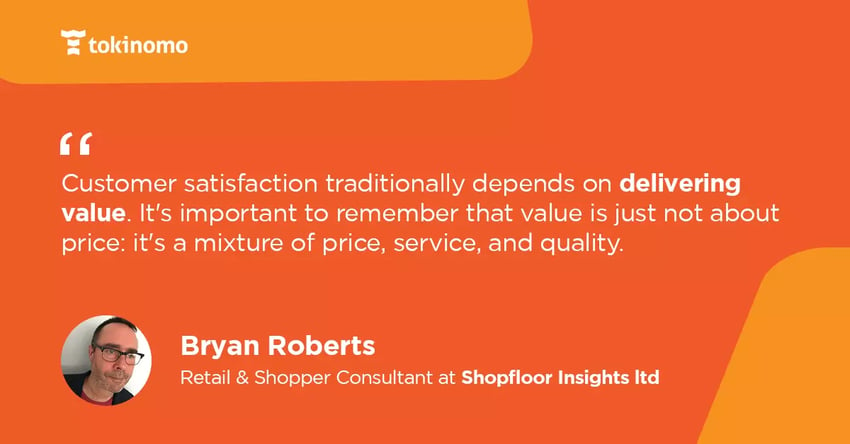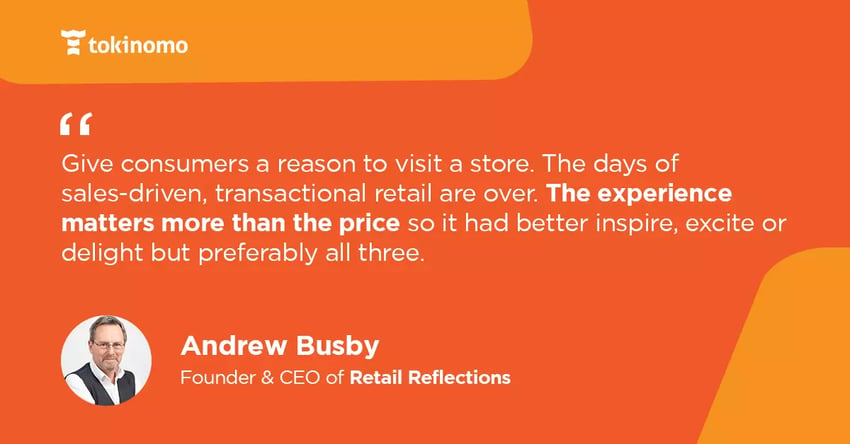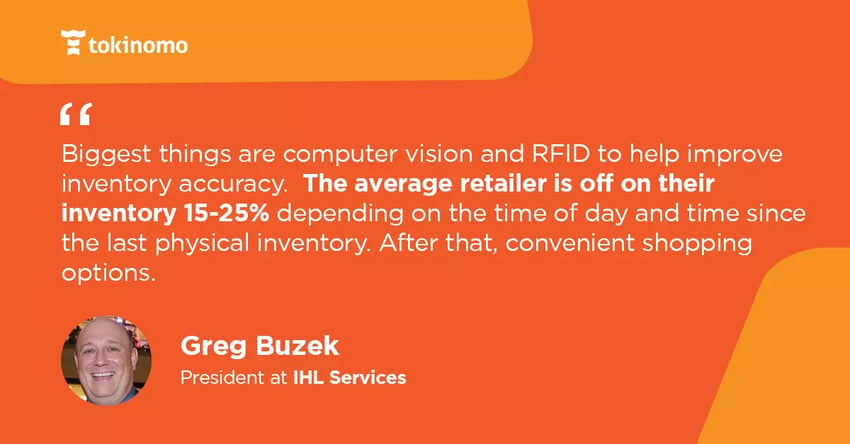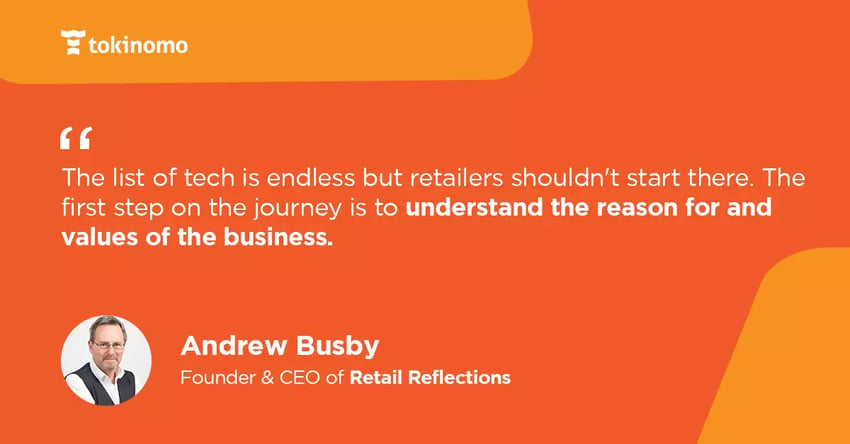We begin this expert round-up with a simple question: What is the most important part of any business? If you thought about the customer, then you are right! This is why we decided to ask 4 of the best retail experts their opinion about customer satisfaction and experience.
Their knowledge and experience will shed some light on this simple, yet pressing subject. Let’s see how retailers and brands can put the customer first and still focus on increasing sales.
(I can’t get no) customer satisfaction
Yes, just like the Rolling Stones complained, many customers are not satisfied with the services in-store. In this section of the expert round-up, we asked the experts more about the first pillar of customer experience: shopper satisfaction. If you are not satisfied with the products or the services in-store, your experience is definitely not going to be one of the best.
So, how can retailers and brands increase customer satisfaction?
“1. The real retailer has to decide what they want the customer experience to be. 2. They need to hire the right people that will deliver the experience. So if you're in the US, you have Nordstrom, which is a really high-level customer experience, you also have Walmart, which is a lower level of customer experience, still very friendly people, but they're there primarily to help a little bit. And check people out as they leave, they're not there to walk them around from department to department to department. So you hire the appropriate person for the appropriate job, you train them properly. That's extremely important because they're properly trained to deliver that level of service. And management will be the role model as to how people are to act.
The way you treat your employees is how the customer is going to be treated. So when it comes to the service side of customer satisfaction, that is one way to go about it. On the other side, which is the experience side, we want to create an experience that's easy and hassle-free.”
Shep Hyken, Customer Experience Speaker at Shepard Presentations
-png.png)
As Shep mentioned, one of the most important parts of any business, if not the most important, is human resources. Without the right employees, the image of your brand can be damaged and shoppers can leave your store without spending a dime.
“The greatest things they can do is be in stock and remove friction in the buying process. Inventory issues are by far the biggest issue. Followed closely by having to stand in line. So, having what they want to buy and creating varied ways of checkout (mobile self-checkout, traditional self-checkout and of course click and collect and delivery) are the two biggest areas.”
Greg Buzek, President at IHL Services
Removing friction is a must, for both retailers and brands. Nobody wants to jump through hoops to make any purchase. Find the problems in the customer journey in-store and online and try to make it as easy as possible for shoppers.
“ More than ever, customers expect that retailers and brands are using the data they have on us in an intelligent, informed manner. This means joining the dots between every engagement so that communication to us is relevant and contextual.
In a digital world, the basics are still extremely important. So have a great call center, empower your call center staff and make it straightforward for customers to get to the information or person they need to reach.
We're now in the age of same-hour delivery times so yours had better be the next day at the very least. Together with an appealing returns policy, this is rapidly becoming the most important factor in customer satisfaction.”
Andrew Busby, Founder & CEO of Retail Reflections
Things are moving faster in 2021. If you are not ready to offer your shoppers their products fast, in a convenient way, and at the right price, then you have no chance of staying on top of the competition.
"Customer satisfaction traditionally depends on delivering value. It's important to remember that value is just not about price: it's a mixture of price, service, and quality. Some retailers have been remarkably successful in delivering value through very low prices and high-quality private label items counterbalanced by a low service environment. On the flip side, other retailers at the premium end of the spectrum have thrived by delivering value through extremely high service levels, quality products, and a premium experience but accompanied by high prices.
Another way of looking at this is in terms of the investment that shoppers make in each shopping trip. Each time they go shopping, they invest time, money, and angst or, in other words, some sort of emotional input. On most occasions, retailers can succeed by minimizing the amount of time and money that shoppers invest whilst also minimizing the level of emotional investment too.
That said, if retailers seek to provide an awesome experience, therefore making the shopping trip a hugely positive one, they can then afford to perhaps charge higher prices and shoppers might be willing to spend more time in those stores. So, it's all a bit of a delicate balancing act. Supermarkets are up against low price competition, who minimizes prices, and online competitors who minimize time. The stores, therefore, have to make sure they are offering an appropriate mix of pricing, product, and environment that maximizes satisfaction."
Bryan Roberts, Retail & Shopper Consultant at Shopfloor Insights ltd

Finding the right balance between price, service, and quality is a must for both retailers and brands in 2021. Customers expect amazing services, great prices, and perfect products, especially after the COVID-19 pandemic made everything stand still for a few months.
Shoppers are in a hurry
Customers are coming back to shop in-store. As retailers see an increase in foot traffic, they also observed that people are spending less time shopping in-store. We wanted to know if our experts had any tips and tricks for retailers that want to grab the attention of their fast-shopping customers while also increasing sales.
"For physical retailers to successfully compete against pure-play online retailers or low-price discount rivals, they have to provide everything that those competitors cannot. These might be exclusive products by way of private labels. There might be incredible levels of customer service through colleagues or through technology. It might be through experiences or physical displays.
There are some categories that many shoppers still prefer to buy in-store, like meat, fish, bread, and fresh produce, where the ability to see, touch and experience the product is still paramount. It is therefore the case that supermarkets really should focus on achieving excellence in these areas. However, in some countries, like the UK, it is noticeable that many supermarkets are pulling back from service counters to cut costs. While this makes total economic sense, I do worry that it might dilute the in-store experience and remove the differentials between these retailers and their online or discount competitors."
Bryan Roberts, Retail & Shopper Consultant at Shopfloor Insights ltd
Human interaction along with a bit of technology can do the trick for retailers that want to catch the attention of shoppers that are in a hurry.
“Give consumers a reason to visit a store. The days of sales-driven, transactional retail are over. The experience matters more than the price so it had better inspire, excite or delight but preferably all three.
Reinvent the concept of the store. Think like an art gallery or a museum and have a fresh new surprise, waiting to be discovered, around every corner.
Rethink your inventory. Does the store need to carry it? Could they be showcases and products shipped from not just central DC's but also high street 'dark' stores.”
Andrew Busby, Founder & CEO of Retail Reflections

Just like the Art Museum in London reinvented itself for a short period of time, so can your store. Andrew offers interesting options to retailers that want to increase sales even when shoppers spend less time in-store.
“So I'm going to take this from the position of the US. What we're seeing happening here is that the stores are opening. And there are safety and health protocols that are put in place for the comfort of the customer. And that is going to make people feel comfortable about coming back. As these protocols change, you're going to see customers become more and more comfortable. We've got where we're seeing here, a surge of in-store shoppers that weren't there before.
People are shopping starting to shop at the normal cadence and styles as they shopped in prior to the pandemic. So things are shifting back. What we have to recognize is that not everybody has the same comfort level. So what I mean by that is, we will always play where health and safety are more important than anything. And we will play to the people that are most concerned about that, at this point, as the shoppers come more and more confident people and things are getting back to normal, protocols are going to change or they're going to shift based on how comfortable.”
Shep Hyken, Customer Experience Speaker at Shepard Presentations
At the moment, retailers need to find a way to make people feel safe and comfortable while shopping. COVID-19 made people put health and safety first and that’s why shoppers expect retailers to make some changes.
“They are spending less time but spending more on each trip. Right now, the browsing trips are very few and far between. The key thing once again is product availability and then to add to this is offers specific to the consumer when on-site to take full advantage.”
Greg Buzek, President at IHL Services
While shoppers might be spending less time in-store, they seem to come with their minds made up to make a purchase. Is showrooming gone?
People are not coming to the store just for products
As we all know, products can be found everywhere nowadays. Shoppers can browse for their favorite grocery items, electronics, and clothes without even moving from the sofa. If they can find products easier, why do they still love to come to the stores?
“ 1.Feel and touch
2. The social interaction
3. Trying out products before they buy”
Andrew Busby, Founder & CEO of Retail Reflections
“I would argue right now this is not necessarily true with the supply chain problems we currently face. However, assuming this is normal time, there are many reasons people prefer to shop in-store. First, it is often easier and more convenient. Second, it is supporting the local economy. Third, people are tired of being cramped up and want to get out. It’s not that they want to stand in line, but socialization is important. Fourth, there remain many problems with online orders for out-of-stocks and then returns. On out-of-stocks, store you can make quick decisions on what you want that are much harder online. And for returns, the online experience remains kludgy for most retailers. And for clothing returns are over 50%.“
Greg Buzek, President at IHL Services
People feel the need to get out, move, and experience new things and stores seem to be one of the ideal places to do so. Also, as Greg Buzek mentioned above, when you order a product online and receive an email that it is out of stock, it is a bit of a hustle to order a new one. However, in-store, you can find a replacement easily.
“Well, the biggest asset of brick and mortar stores is that customers get to touch and see the products they want to buy. And that's experiential. Also, the people inside the store, because there's an emotional connection. People don't do business with a company, they don't go to the retailer and do business at a store. They do business with people inside the store.
And if I go into a mall, and I'm going to buy a T-shirt, I have a choice I can buy at 10 different stores. Why do I buy at this store instead of the nine others? Many times it's because I liked the way they treated me. I really liked that salesperson. Because people make the difference. And we need to create this, I call it the awesome responsibility. This is kind of more of a tactic that we teach, where we want all employees to recognize that at any given time, they are the representation of the entire brand, doing business with this person, and they're gonna make or break my experience. So that employee needs to recognize that awesome responsibility. And they need to be thinking about what am I doing right now that's going to make sure that that customer wants to come back to this store, the next time they need whatever it is that we sell.”
Shep Hyken, Customer Experience Speaker at Shepard Presentations
-png.webp?width=850&name=Shep-Hyken-2%20(1)-png.webp)
As social animals, we crave human interaction and studies show that isolation can have a negative impact on our health. People come to the store to connect with other people. Just as Shep Hyken mentioned, shoppers usually select a store for their salespeople, not just for the products.
"I think the problem here is that, in the case of groceries, some shoppers don't love to shop in stores. They see it as a chore that has to be completed. I think this is a great shame as food and drink could and should be a retail experience that could be delightful. Food and drink shopping could be a sensory experience, utilizing sight, taste, sound, and scent.
But many grocers have commoditized the experience to such an extent that it has ceased to offer any aspect of enjoyment. Other supermarkets, however, particularly some that I've experienced in the US, Europe, and South Africa are really swimming upstream and seeking to offer their shoppers a real sensory experience, full of taste, smells, and visual experiences that really delight. Suppliers have a role to play here too. Through displays, experiences, competitions, or events, they can really elevate the shopping experience and provide retailers with differentiation."
Bryan Roberts, Retail & Shopper Consultant at Shopfloor Insights ltd
Making shopping less of a chore and more of a sensory experience can benefit both the retailers and the customers. As Bryan Roberts suggested, with the right displays and experiences, retailers can surprise their customers.
Offering a better customer experience in-store
We’ve been talking about customer satisfaction and the multiple opportunities for retailers to catch the attention of shoppers, but what about customer experience? How can retailers offer that experience every customer is looking for?
“We want to create a convenient experience. The way they shop today has been accelerated because of the pandemic. Now, shoppers expect to be able to go to a website, look at what's on the website, decide if they want to buy it through the website or go to the store. If they go to the store, they want to have a choice of walking to the store and getting it or picking up curbside. BOPIS has been available for a few years, but the pandemic accelerated its growth.
Convenience is going to increase the experience that the customer has with that retailer. So you have to make the experience convenient. If I walk into a store, and I see long lines. Okay, that's inconvenient. If I can't find somebody to help me, and I'm in the type of store where there should be somebody there to help me. That's inconvenient. Anytime you have friction, you basically lower the opportunity to win that customer back, because a competitor is going to figure out how to eliminate that friction.”
Shep Hyken, Customer Experience Speaker at Shepard Presentations
As it is with most experiences, retailers need to think about convenience first. Imagine going to the store and waiting in line for ages to pay for your products. Even if you had an amazing experience in-store, the fact that it wasn’t convenient for you to wait turned the whole shopping trip into a bad experience.
"Lots of retailers are investing time and money to try and lubricate the shopper’s journey. Often this can be through technology such as the introduction of smart checkouts, self-scanning, or smart carts. That enables the shopping trip to be completed more easily and often more quickly. Other retailers are also investing heavily into the look and feel of their store, seeking to move away from the lowest common denominator approach of some of their discount competitors and really trying to play up the sensory aspect of grocery shopping.
Others are realizing the power of partnerships: linking up with third-party retailers or food service providers to enhance the appeal of their stores and provide more of a one-stop shopping experience that covers different consumption occasions. Pre-pandemic, lots of calories were being consumed out-of-home. Obviously, COVID reversed this trend, but as the pandemic subsides, I would expect to see the out-of-home trend resume its upward trajectory. This means providing in-house food-for-now or food-for-later opportunities or partnering with other businesses to provide these services."
Bryan Roberts, Retail & Shopper Consultant at Shopfloor Insights ltd
Apart from making the customer experience convenient, you also need to find opportunities to expand your business. Partnering with other retailers or food services is a great option.
“Being in-stock and removing friction. Finally, well-trained and friendly associates. These associates are a key part of things and one of the reasons that companies like Publix and Chick Fil A make as much as 4-5x profit of their competitors.”
Greg Buzek, President at IHL Services
Don’t forget about the basics! Always keep an eye on the stock and make sure that you make the shopping journey as smooth as possible.
“ Make it simple and easy. Understand that there are multiple different shopping journeys - distressed, browsing, essential, luxury. Cater to what your customers want.
Know your customers. I order from Amazon and despite the fact that they know my name (and an awful lot more besides) they still address me as 'A'. That's not knowing your customer, that's taking liberties.”
Andrew Busby, Founder & CEO of Retail Reflections
You can’t offer the right experience to your shoppers if you don’t understand their needs. Don’t make assumptions and understand that there are different shopping journeys.
Technology - A helping hand for retailers and brands
Even before we asked them, the retail experts pointed out the importance of technology. However, to dig deeper we wanted to know what are their favorite technologies and tools that can make the customer experience both convenient and entertaining.
"As I've already mentioned, the key pain point for shoppers is often the checkout experience and lots of retailers and tech providers are working together to try and ease this. Instore navigation is often another issue and I'm amazed that more retailers haven't done more to address this through technology, helping shoppers compile shopping lists and then navigate the store in the most efficient manner.
I think there's also a lot more scope for more innovative tech-driven shopper marketing. Be that through innovative digital POS, gamification, or the use of more attention-grabbing shopper marketing techniques that break up the monotony of a shopping trip and actually bring a smile to shoppers’ faces - something that happens far too infrequently."
Bryan Roberts, Retail & Shopper Consultant at Shopfloor Insights ltd
Digital and robotic POP displays can make the shopping experience entertaining because they can easily grab the attention of shoppers. Also, they are much more engaging than a cardboard display.
“Biggest things are computer vision and RFID to help improve inventory accuracy. The average retailer is off on their inventory 15-25% depending on the time of day and time since the last physical inventory. After that, convenient shopping options.”
Greg Buzek, President at IHL Services

Besides robotic displays, RFID and computer vision can be helpful technologies for retailers that care about their customers’ experience.
“One of the reasons people love going to the store is the way that store looks and works. If it's merchandise correctly if it looks good if you're in a clean store if there's good lighting if there's easy parking and so on. Also, once the shoppers come, they expect the retailer to make it convenient for them to shop there.
For that, you want to eliminate any friction you can. And if that means they walk a shorter distance that could be considered friction, if you're in a major box store, and you've got to go from one end of the store to the other end of the store. I don't mind that, but some people might. So we want to eliminate friction, you want to create self-service tools. This is where the technology comes in. What can I provide my customers with so that they can take control?
If you want to use technology to be able to purchase you’d expect the retailer to give you a BOPIS option.
Also, another common example is when people want to know if a certain product is available in the store. Retailers can have a website that only indicates if the item is available in a certain store or another. So if you're using technology to drive that self-service you are offering a convenient experience.
Customer experience is really important. 83% of Americans are willing to switch because of the bad customer service experience. But more important than that, I believe 75% of people are willing to pay more money for a better experience. Offering a better and more convenient experience to customers is the key that can help increase sales.”
Shep Hyken, Customer Experience Speaker at Shepard Presentations
Offering an amazing experience in-store (and online) can lift sales. Why? Because people are ready to pay more if they receive an experience along with the products.
“The list of tech is endless but retailers shouldn't start there. The first step on the journey is to understand the reason for and values of the business. What does it stand for? What makes it famous? Once that is fully understood, the tech decisions become easier.”
Andrew Busby, Founder & CEO of Retail Reflections

It’s easier to find the right tools when you know what you are looking for. It’s better to see what your business stands for before diving into the newest trends out there. Just as Andrew Busby mentioned, you have so many options when it comes to technology, but you need to find the right tools for your business.



